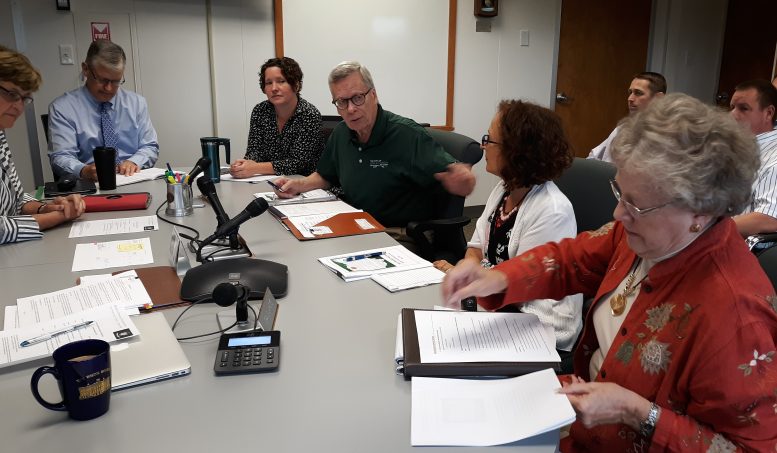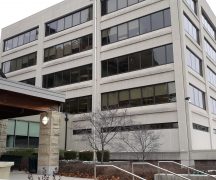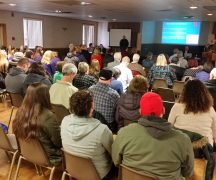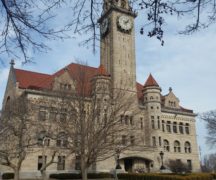By JAN LARSON McLAUGHLIN
BG Independent News
“Help wanted” signs are going unanswered in Wood County. So local officials are looking at attracting immigrants to the region to fill those openings.
Bowling Green initially wanted to put out a welcome mat to immigrants because it was the right thing to do morally. Then as city officials researched the idea, they discovered it was also the right thing to do economically.
As evidenced by the number of “now hiring” signs posted in the region, Bowling Green and Wood County economic development officials have been hearing for months that the region is running low on workers.
In May, Wood County economic development officials were celebrating a banner year in business expansions – creating nearly 1,000 new jobs. But the issue waiting in the wings was the low unemployment in the region, wavering between 3 and 4 percent.
While that low rate is great news to employees, it is worrisome to economic development officials.
“It’s a good thing. But there is going to be a time when new businesses slow down looking at Northwest Ohio,” Wade Gottschalk, executive director of the Wood County Economic Development Commission, said earlier this year to the county commissioners.
On Tuesday, the county commissioners heard the same warning – this time from Bowling Green officials.
“We hear the same message time and time again,” Mayor Dick Edwards said. “We need good workers.”
City Council passed a resolution in 2017 welcoming immigrants and “condemning any discrimination, harassment or unjustified deportation of immigrant residents.” As the initiative was researched, it became obvious that the welcome mat could have far-reaching economic benefits.
Ohio Means Jobs estimates there are 9,200 job openings within a 20-mile radius of Bowling Green.
“We are looking for skilled and other kinds of workers to come to Wood County and Bowling Green,” Edwards said.
While Ohio has always been looked upon favorably by companies because of the region’s work ethic – that means nothing if there aren’t people to fill jobs.
Wood County Commissioner Craig LaHote said site selection teams will notice if the available workforce is too low. “We might get ruled out before they look at anything else,” he said.
Communities around the region – like Toledo and Sandusky – have already adopted “welcoming” initiatives.
And while the success of the region and Wood County to bring jobs here is great, it has created a critical need to attract more workers to the area, said Sue Clark, director of Bowling Green’s economic development commission.
“That only makes the workforce demand more crucial,” Clark said.
Clark explained the local effort is being designed to welcome immigrants and refugees. She listed possible refugees escaping the war in Syria or the unrest in Central America.
“We’re not talking about bringing in illegal immigrants,” she said.
The initiative would also extend the welcome mat to international students who come to Bowling Green State University.
“We do not make it particularly easy for them to find a job and stay on,” Clark said.
Beatriz Maya, from LaConexion and a member of the Welcome BG Task Force, said the initiative makes economic sense.
“This is based upon hard demographic data,” Maya said. “There is a shortage of more workers, for a younger workforce.”
Companies that can’t find workers won’t come here in the first place, and those here may pick up their roots and go elsewhere, she said.
“They are going to leave,” Maya warned.
A “welcoming” initiative will be most effective if it is regional, Maya said. “We cannot stop at the Bowling Green city limits,” she said. “Our rural areas are suffering.”
Clark agreed. “We can’t do this alone. This has to be a countywide effort.”
Gottschalk is already exploring that regional effort by joining a Toledo study on regional needs. “We want to discover where our gaps are for jobs,” he said.
Wood County Administrator Andrew Kalmar asked about the next step if the county wants to work with Bowling Green to be welcoming.
Edwards listed off some of the goals, such as addressing racism and discrimination, identifying access to health care, developing trust between immigrants and law enforcement, and working with schools to help new people settle in.
Also, employers need to be educated about hiring immigrants.
“Fostering this welcoming environment in any way,” the mayor said.
Edwards mentioned the value of America’s “welcome mat” when his own family immigrated to the U.S. from England and Scotland in the late 1800s and early 1900s.
“It was a chance for a better life,” he said of his family’s journey here. Of course, times were different then. “The welcome mat was out for anyone with or without skills.”
Wood County Commissioner Doris Herringshaw said the county would discuss the city’s invitation to join in the welcoming efforts.
“It’s certainly worth a lot more discussion, and figuring out the next steps forward,” Herringshaw said. “Having a workforce is important to us – needless to say.”
Recommendations from the task force are:
- Appoint a steering committee to oversee the implementation.
- Hire a part-time “Welcome BG” consultant on a one-year renewable contract.
- Expand the initiative to include Wood County.
- Brand Bowling Green as a “Welcoming City” to increase visibility and community awareness.
- Connect local employers with identified labor pools, including international students, millennials, immigrants and refugees.
- Engage resources to overcome current barriers to attracting and retaining a needed labor force.
- Engage with BGSU to attract/retain international students and millennials.
- Support immigrant business ownership/micro enterprises.
- Develop a Welcome BG Ambassadors program to help newcomers settle and integrate.
- Increase access to quality and affordable housing through processes like the BG Improvement Plan and the Community Action Plan.
- Identify and address needs to support language access.
- Identify and address transportation barriers.
- Promote multicultural events and entertainment.
- Address issues of systemic racism, stereotypes, harassment and bullying.
- Identify needs and ways to access health care and dental services.
- Increase trust-building efforts between the community and the police.
- Foster a welcoming environment in schools.
- Advance welcoming policies and practices for the benefit of the whole community.





